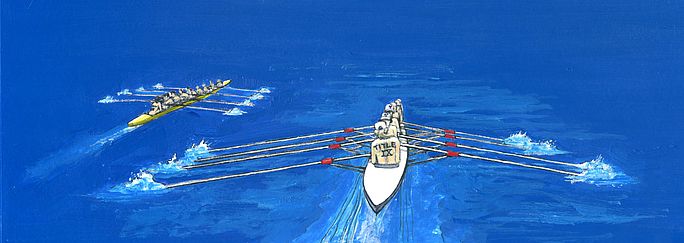Click! in the Classroom
Inspiring Girls in Sports
Grade Level: Grades 3-6 | Estimated Time: One class period |

Introduction
Girls need role models if they are going to be inspired to participate in sports. They also need to counter stereotypes about girls and women in sports. This lesson introduces students to the subject of sports.
Learning Objective
Students will be able to better understand how our ideas about “girls” and “boys” influence our perceptions about sports.
Essential Questions
How do stereotypes influence our perceptions of sports?
How are cultural activities, like sports, socially important?
Materials
Technology Needs: Computer with Speakers and Internet Access; Printer/Copier
This Lesson Plan (PDF)
Mind Map (PDF)
Pencils/Pens
Teacher’s Class Preparation
Read the Click essay “Sporting Bodies” in the chapter Body & Health.
Watch the clip from the film “Media Coverage and Female Athletes” (16:13 min.)
Warm Up Activity: Mind Map
Have the students fill in a Mind Map (PDF) with “Sports Stars” in the center.
Guide them to write words they associate with the term “Sports Stars.”
Discuss their word associations and write their words on the board.
Ask them to think about how their Mind Map would be different if the central circle contained the phrase “Female Sports Stars” or “Girl Athletes.”
Conclude the lesson by having the class discuss moments in history where girls and women have made great breakthroughs in sports.
Main Activity: Small Group/Pair Discussion followed by Class Discussion
Divide the class into small groups or pairs.
Tell the students they are going to be learning about stereotypes.
Explain that stereotypes are generalizations.
We use them to categorize people when we don’t know the whole person.
They are built from assumptions, which are ideas we take for granted, and from beliefs, which are ideas passed down to us from authorities.
A stereotype is a wrong idea that all the people in a certain group are the same. It is a wrong idea that all people in a certain group think the same way.
Gender stereotypes influence how we think about what it means to be a “boy” and what it means to be a “girl.”
Stereotypes influence how we interact with other people in the classroom and on the sports field.
Ask the students to consider this common stereotype: girls do not like sports.
Ask them to consider this one: girls are not good at sports.
And: boys like sports.
And: boys are good at sports.
Have the groups or pairs discuss these stereotypes.
They may find it useful to refer to their Mind Maps.
Guide them to expand on gender stereotypes.
Guide them to give specific examples of people who do not fit the stereotypes.
Bring the class back together and have the groups/pairs share their specific examples. Discuss why gender stereotypes hurt both boys and girls.
How did the Yale women’s rowing team protest the lack of equal facilities — a violation of Title IX?
Excerpt from “A Hero For Daisy,” a film by Mary Mazzio. (Running time 3:12) Used with permission. The complete film is available from 50 Eggs, Inc.
Extension Activity: Title IX (for more advanced students)
Have students bring to class pictures of women sports stars who inspire them.
After they have shared their pictures with the class, introduce the students to Title IX.
Show a clip from the film “A Hero for Daisy” (3:12 min.), also located at right.
Introduce the students to Title IX by reading to them the Click section on Title IX:
“The words ‘Title IX’ have become practically synonymous with women’s sports, but the original law said nothing about athletics. Instead it was designed to address general patterns of discrimination and inequality in education, such as quotas that limited women’s enrollment in professional schools or the practice of automatically expelling students if they became pregnant. Pretty soon it dawned on many people that the area in education where disparities in treatment for women were the most extreme was the field of sports.
As bureaucrats in Washington tried to figure out how to implement the law (a process that took most of the 1970s), those with a vested interest in the sports status quo (especially football coaches) made it sound like the world would end if women shared the sports dollar on a par with men. But sports activists had the law on their side, and they put it to good use. [As they have now seen in the film clip about the 1976 Yale women’s crew protest.]
Indeed, the 1970s proved a breakthrough decade for women in sports. In one frequently cited figure, high school sports participation rates for girls rose from one in 27 in 1971 to one in three by 1979. Not all that progress can be attributed specifically to Title IX, but the amendment definitely acted as an important spur. In addition to expanded opportunities for team sports on the high school and collegiate level, individual women’s sports also enjoyed broader public support, spurred by the tennis and running booms of the 1970s, followed by the popularity of aerobics in the 1980s. Being female now increasingly included being physically fit and active.”
Common Core Anchor Standards
Speaking and Listening
Comprehension and Collaboration:
CCSS.ELA-LITERACY.CCRA.SL.1
Prepare for and participate effectively in a range of conversations and collaborations with diverse partners, building on others' ideas and expressing their own clearly and persuasively.
Presentation of Knowledge and Ideas:
CCSS.ELA-LITERACY.CCRA.SL.4
Present information, findings, and supporting evidence such that listeners can follow the line of reasoning and the organization, development, and style are appropriate to task, purpose, and audience.
CCSS.ELA-LITERACY.CCRA.SL.6
Adapt speech to a variety of contexts and communicative tasks, demonstrating command of formal English when indicated or appropriate.
How to Navigate our Interactive Timeline
You will find unique content in each chapter’s timeline.
Place the cursor over the timeline to scroll up and down within the timeline itself. If you place the cursor anywhere else on the page, you can scroll up and down in the whole page – but the timeline won’t scroll.
To see what’s in the timeline beyond the top or bottom of the window, use the white “dragger” located on the right edge of the timeline. (It looks like a small white disk with an up-arrow and a down-arrow attached to it.) If you click on the dragger, you can move the whole timeline up or down, so you can see more of it. If the dragger won’t move any further, then you’ve reached one end of the timeline.
Click on one of the timeline entries and it will display a short description of the subject. It may also include an image, a video, or a link to more information within our website or on another website.
Our timelines are also available in our Resource Library in non-interactive format.
Timeline Legend
Yellow bars mark entries that appear in every chapter
This icon indicates a book
This icon indicates a film
1971 The Click! Moment
The idea of the “Click! moment” was coined by Jane O’Reilly. “The women in the group looked at her, looked at each other, and ... click! A moment of truth. The shock of recognition. Instant sisterhood... Those clicks are coming faster and faster. They were nearly audible last summer, which was a very angry summer for American women. Not redneck-angry from screaming because we are so frustrated and unfulfilled-angry, but clicking-things-into-place-angry, because we have suddenly and shockingly perceived the basic disorder in what has been believed to be the natural order of things.” Article, “The Housewife's Moment of Truth,” published in the first issue of Ms. Magazine and in New York Magazine. Republished in The Girl I Left Behind, by Jane O'Reilly (Macmillan, 1980). Jane O'Reilly papers, Schlesinger Library.


